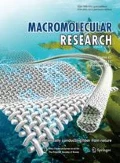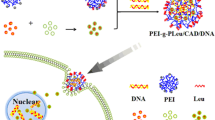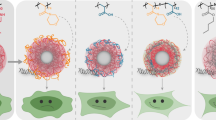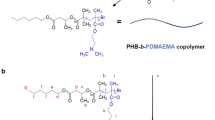Abstract
Branched polyethylenimine (bPEI) has long been considered as a gold standard for non-viral gene transfection owing to its excellent gene condensing property and consistent transfection efficiency in various cells. On the other hand, the undesirable cytotoxicity profiles of bPEI limits its use in clinical applications. This study presents a facile way of improving the cytotoxicity of bPEI by grafting a biodegradable polyester chains (PEI-g-poly(lacticco-glycolic acid), PEI-g-PLGA). Remarkable improvement in cell viability and reduction in cell membrane damages could be observed with PEI-g-PLGA. In addition, PEI-g-PLGA did not cause serious erythrocyte aggregation, which is in contrast to bPEI. The copolymer formed spherical cationic micelles that facilitate the formation of polyelectrolyte complexes by interacting with plasmid DNA. The hydrodynamic size of the complexes ranged from 120 to 200 nm. Although PEI-g-PLGA demonstrated slightly lower transfection efficiency than bPEI 10 kDa, the copolymer can be considered as a potential non-toxic candidate gene carrier for clinical gene therapy, where a large dose or repeated administration would be needed for an extended period of time.

Similar content being viewed by others
References
J. H. Jeong, S. W. Kim, and T. G. Park, Prog. Polym. Sci., 32, 1239 (2007).
B. Demeneix and J. P. Behr, Adv. Genet., 53PA, 215 (2005).
B. I. Florea, C. Meaney, H. E. Junginger, and G. Borchard, AAPS PharmSci, 4, E12 (2002).
O. Boussif, F. Lezoualc’h, M. A. Zanta, M. D. Mergny, D. Scherman, B. Demeneix, and J. P. Behr, Proc. Natl. Acad. Sci. U.S.A., 92, 7297 (1995).
A. Akinc, M. Thomas, A. M. Klibanov, and R. Langer, J. Gene. Med., 7, 657 (2005).
D. Fischer, T. Bieber, Y. Li, H. P. Elsasser, and T. Kissel, Pharm. Res., 16, 1273 (1999).
W. T. Godbey, K. K. Wu, and A. G. Mikos, J. Biomed. Mater. Res., 45, 268 (1999).
A. von Harpe, H. Petersen, Y. Li, and T. Kissel, J. Control. Release, 69, 309 (2000).
R. Deng, Y. Yue, F. Jin, Y. Chen, H. F. Kung, M. C. Lin, and C. Wu, J. Control. Release, 140, 40 (2009).
L. Aravindan, K. A. Bicknell, G. Brooks, V. V. Khutoryanskiy, and A. C. Williams, Int. J. Pharm., 378, 201 (2009).
R. K. Oskuee, A. Dehshahri, W. T. Shier, and M. Ramezani, J. Gene. Med., 11, 921 (2009).
A. Zintchenko, A. Philipp, A. Dehshahri, and E. Wagner, Bioconjug. Chem., 19, 1448 (2008).
M. L. Forrest, G. E. Meister, J. T. Koerber, and D. W. Pack, Pharm. Res., 21, 365 (2004).
J. H. Jeong, S. H. Song, D. W. Lim, H. Lee, and T. G. Park, J. Control. Release, 73, 391 (2001).
Y. B. Lim, S. M. Kim, H. Suh, and J. S. Park, Bioconjug. Chem, 13, 952 (2002).
J. R. Fraser, T. C. Laurent, H. Pertoft, and E. Baxter, Biochem. J., 200, 415 (1981).
J. H. Jeong, Y. Byun, and T. G. Park, J. Biomater. Sci. Polym. Ed., 14, 1 (2003).
Y. S. Nam, H. S. Kang, J. Y. Park, T. G. Park, S. H. Han, and I. S. Chang, Biomaterials, 24, 2053 (2003).
K. Yasugi, Y. Nagasaki, M. Kato, and K. Kataoka, J. Control. Release, 62, 89 (1999).
A. C. Hunter, Adv. Drug. Deliv. Rev., 58, 1523 (2006).
S. M. Moghimi, P. Symonds, J. C. Murray, A. C. Hunter, G. Debska, and A. Szewczyk, Mol. Ther., 11, 990 (2005).
D. Fischer, Y. Li, B. Ahlemeyer, J. Krieglstein, and T. Kissel, Biomaterials, 24, 1121 (2003).
J. M. Benns, J. S. Choi, R. I. Mahato, J. S. Park, and S. W. Kim, Bioconjug. Chem., 11, 637 (2000).
J. H. Jeong and T. G. Park, J. Control. Release, 82, 159 (2002).
Author information
Authors and Affiliations
Corresponding authors
Rights and permissions
About this article
Cite this article
Lee, M.S., Kim, M.G., Jang, Y.L. et al. Polyethylenimine-g-poly(lactic-co-glycolic acid) as non-toxic micelle-type carrier for gene delivery. Macromol. Res. 19, 688–693 (2011). https://doi.org/10.1007/s13233-011-0715-1
Received:
Revised:
Accepted:
Published:
Issue Date:
DOI: https://doi.org/10.1007/s13233-011-0715-1




